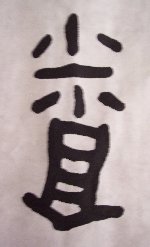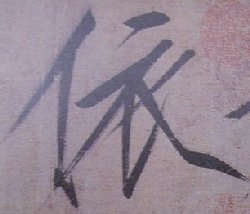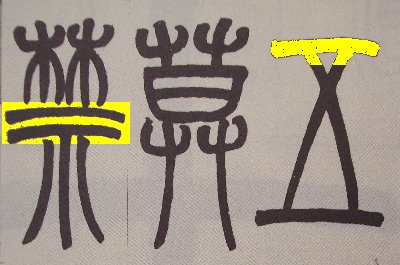
Principles of Chinese Calligraphy
Brush Treatments & Basic Strokes
P4: Principles of Operating the Brush (Brush Treatments or Brush Movements) 運筆法
“Hold the brush as if the brush and our hand and body are one. The brush is only an extension of our mind and intention. When we focus deeply, the brush and our body do not exist. It’s only the mind that is working, without confinement of brushwork.”
|
|
There are many operating principles to execute various strokes in Chinese calligraphy. It is often maintained that the aesthetics of Chinese calligraphy are the product of Brush Treatments. The brush treatments of Chinese calligraphy are somewhat similar to Chinese Brush Painting, but are totally different from Western painting and calligraphy and Chinese pen writing. The techniques described below are not isolated. They are related to each other and form an integral structure for each character. It would be extremely lengthy to describe all of their details, delicacy or nuances in words. So I decide to use pictures and video clips. The readers may recognize details per their understanding and observation from the videos.
In practicing Chinese calligraphy, be sure to apply each principle in every stroke in a very slow or moderate pace. A fast writing speed will pass over the aspects being emphasized and is not recommended for beginners and is not worth bragging.
Basic principles of Brush Treatments
( 基本運筆法
) can be summarized into the following
techniques:
§ 4.1- Hiding the Hairs’ Tip “Tsun Fong ( 藏鋒 )” -
Wrap
The tip of the brush has a central part consisting of sharp and long hairs in the middle, and its surrounding layers of shorter hairs. If we spread the hairs evenly, we will see that the hairs in the middle at the tip are tiny, thin, and sharp. This is called “Fong 鋒 ” - the tip or “sharpness” of the brush.
“Sharpness” here means the thrusting and cutting power of the brush that generates “explicit” features of a stroke. The "implicit" features come from the writer's personality, mental stage, insights, and
etc. “Tsun Fong” refers to the first and last touches of the brush tip on the paper should be hidden “implicitly” in writing each stroke. For most Chinese calligraphy styles, in starting and closing each stroke we do not reveal these touches “explicitly”. This enables the sharpness of the brush hairs to be hidden “Tsun 藏” in the strokes of the characters. A stroke with “Tsun Fong” imparts a suggestion of power and strength, but not revealing all that is in the mind of the calligrapher. This is based on Chinese philosophy and belief to spare the thrusting power in order to sustain energy and vitality and to exemplify
humbleness, politeness, and a higher level of wisdom and skill.

A Jin Wen character that emphasizes Tsun Fong

Tsun Fong
in various strokes
Adapted Chinese Articles:
Article 1
§ 4.2 - Revealing the Hairs’ Tip “Lo Fong ( 露鋒 )”
Lo Fong, in contrast, means a deliberate reveal of the sharpness of the brush hairs, giving viewers with a sense of directness. There are some Chinese calligraphy styles that utilized the “Lo Fong” technique.

Calligraphy
by Emperor Sung Huei Zong

Video demo of Lo Fong
§ 4.3 - Returning the Hairs’ Tip “Huei Fong ( 回鋒 )” - Return
Huei Fong means turning the brush tip just a little bit in the direction opposite to the direction we intend to go in a stroke. For example, if we want to write a horizontal stroke from left to right, we begin by pressing the brush tip to the left and then moving the brush a little bit circularly and then we write the stroke to the right. Finally, near the right end of the stroke, we end by returning a little bit circularly to the left. The sharpness of the brush tip will then be contained within the stroke.

Video demo of Huei Fong
§ 4.4 - Rounding the Hairs’ Tip “Zhuan Fong ( 轉鋒 )”
Zhuan Fong is used to write a round dot. When the hairs’ tip moves continuously in a circular motion, a dot will be round.

Video demo of Zhuan Fong
§ 4.5 - Folding the Hairs’ Tip “Zhe Fong ( 折鋒 )”
Zhe Fong is used to write square or angular strokes. “Zhe” means to bend or fold.

Video demo of Zhe Fong
§ 4.6 - Centralizing the Hairs’ Tip “Zong Fong ( 中鋒 )”
Zong Fong or centralizing the tip of the brush refers to keeping the brush tip always in the middle of the stroke. (The opposite of Zong Fong is Tse Fong.) In this way the strokes will be full of strength and vigor. Ancient Chinese calligraphers tended to overstress Zong Fong because it’s the core of all Chinese calligraphy theories. Nowadays many, many Chinese calligraphers write about Zong Fong theories but they violate this principle in doing strokes because of lack of technical control or self-awareness. The technical deficiency arises from lack of knowledge or
the awareness that we should never bend the brush from top to the hairs’ tip. If we ever need to bend a little bit, it should be less than five
to ten degrees or minimized. Those who bend the brush during writing often tend
to drag or broom with the brush and the results of strokes are not as
vivid and spirited as those done with Zong Fong techniques.
|
Violating Zong Fong Principle
|
Video demo of Zong Fong
|
If
one can do the Center Tip Principle properly, it's very likely that the
practitioner will reach a higher artistic level in Chinese calligraphy. More
details in P5: Center Tip Principle.
§ 4.7 - Side Cutting the Hairs’ Tip “Tse Fong ( 側鋒 )”
Tse Fong means starting a brush stroke in a sideway manner. Ancient Chinese calligraphers described Zong Fong as a means to exert vigor while Tse Fong as a means to achieve elegance. Wang Hsi-Chih’s calligraphy perfectly blended both Zhong Fong and Tse Fong to create beauty and elegance. (This is probably the reason why critics said his works lacked masculine and manhood.)


| Zhao Chih-Chian ( 趙 之 謙 ) used Tse Fong at the start of each stroke to emulate Chin Zuan which was written with all Zong Fong techniques. Zhong Fong is much more difficult to implement than Tse Fong. Tse Fong makes the work look more expressive and interesting but less vigorous. |

Video demo of Tse Fong
Those operating techniques are not conclusive. They are just the basic rules. When one
gains more experiences and reaches a higher level and understands the nature of a brush,
s/he may blend delicately those methods combined with one's insight to create a unique effect of brushwork.
Mastering these basic Brush Treatments of Chinese calligraphy is the
prerequisite of doing Chinese Brush
Painting.